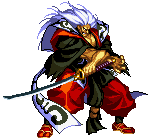3 Ninjas. Mighty Morphin Rangers. Teenage Mutant Ninja Turtles. Beverly Hills Ninja.
Children have a fascination with the mysterious Ninja warriors of ancient Japan. Every
Halloween they go trick-or-treating as Ninja - dressed in black, wearing hoods and sporting
plastic Ninja swords. Fortunately the image of the Ninja in our society today is shifting to a
more accurate depiction than the sinister henchman image of the 1980s. Ninja were not
evil assassins who killed for fun. Ninja did engage in guerrilla warfare and espionage when
necessary, but for the most part they were ordinary people who developed certain skills in
order to survive the difficult times in feudal Japan's history.
"Ninjutsu" is usually translated as the "art of stealth." The Japanese character, "nin" (also
translated as "shinobi") has many meanings, such as perseverance, endurance, and
sufferance. The term Ninjutsu is most commonly used to refer to the specific methods and
techniques used by the Ninja. Ninjutsu as a way of life didn't happen overnight. It developed
over the course of many years. The name Ninjutsu itself didn't come about until several
generations after the Ninja lifestyle began.
Ninjutsu was created in central Honshu (the largest of the Japanese islands) about eleven
hundred years ago. It was developed by mountain-dwelling families in an area not unlike
the American Appalachians, where the terrain is rugged and remote. Ninja families were
great observers of nature. They felt a close connection to the Earth, similar to the Native
Americans, and their lifestyle was one that lived according to the laws of Nature, not
against it. Ninja were also very spiritual people, and their beliefs became an integral part of
Ninjutsu.
One of the spiritual influences was Shinto, "the way of the kami." Kami is the Japanese
word for "god" or "deity." It implies, however, a feeling for a sacred or charismatic force,
rather than a being. The early Japanese regarded their whole world: the rivers, mountains,
lakes, and trees, to have their own energy and spirit.
Another spiritual influence on the Ninja was Mikkyo. Mikkyo, for the Ninja, was not a
religion as much as it was a method for enhancing personal power. These methods
included the use of secret words and symbols to focus their energy and intentions toward
specific goals.
It is generally accepted that the methods found in Ninjutsu originated outside of Japan.
After the fall of the T'ang dynasty in China, many outcast warriors, philosophers, and
military strategists escaped to Japan to avoid punishment by the new Chinese rulers. It is
believed that Ninja families were exposed to many of these exiled people's sophisticated
warrior strategies and philosophies over the centuries, helping to influence and shape what
became Ninjutsu.
The Ninja were also very much influenced by a group of people called Shugenja, who
roamed the same mountainous sections as the Ninja. The Shugendo method of spiritual
self-discovery consisted of subjecting oneself to the harsh weather and terrain of the area
in order to draw strength from the earth itself. They would walk through fire, stand beneath
freezing waterfalls, and hang over the edges of cliffs in an effort to overcome fear and
assume the powers of nature.
It would be incorrect to say that these three spiritual methods were the actual roots of
Ninjutsu, but there is little doubt that they were a large influence. Ninjutsu was and is a
separate philosophy.
The Ninja were not particularly warlike, yet they were constantly harassed by the ruling
society of Japan. They were routinely subjected to unfair taxation and religious
persecution. The Ninja eventually learned to act more and more efficiently in their own
self-defense. They used their superior knowledge of the workings of nature, as well as
specific military techniques passed down through the years, as weapons against the
numerically superior government armies. They used any ruse, harbored any superstition,
and employed any strategy to protect themselves. If necessary, they would use devious
political manipulations to ensure peace.
There were as many as seventy or eighty Ninja clans operating in the Koga and Iga regions
of Japan during the height of Ninja activity. Most of these Ninja were descendants of, or
were themselves, displaced samurai. Therefore, they operated on the sidelines of the
political schemes of the government. Sometimes a Ninja family would use its military or
information-gathering resources to protect its members from becoming victims in a power
play between competing samurai clans. Occasionally, a Ninja family would support one
faction over another, if they felt it to be to their advantage.
As with any society, there were renegades who misused the training they received.
Occasionally, "Ninja" would rent themselves out for espionage or assassination work.
Unfortunately these outcasts have become the stereotype of the "evil ninja" that we see
today in the media. They were, however, a minority. The average Ninja worked very much in
conjunction with his family and community goals.
Ninja were not always primarily soldiers. Of course, certain Ninja operatives, or genin, were
trained from childhood as warriors. But this training was usually precautionary. Genin Ninja
knew that they might be called to help protect the community at some future time, but,
they often spent most of their lives as farmers or tradespeople. Ninja intelligence gatherers
sent to live in the strongholds of potential enemies were rarely required to act openly.
If an operative was called to action it was as a result of a carefully plotted, and usually
desperate, plan. The genin would be contacted and assigned a mission by his chunin
superior. The chunin, or middle man, was a "middle-man" between the jonin family leader
and the operative. Jonin made all philosophical and long-range strategic decisions for the
clan. Often, the identity of the jonin was kept secret from chunin and genin, alike. Of
course certain historical periods required more secret activity than others.
Eventually this activity virtually died out altogether but the legacies, in some cases,
remained.

Although there has been an evolution of Ninjutsu as a life philosophy over the centuries, the
fundamental principles have remained virtually unchanged. Togakure ryu Ninjutsu is more
than 800 years old. Except for a relatively short period of notoriety prior to the reign of the
Tokugawas, the art lived quietly in the hearts of just a few people. The Ninja were a
separate society from the urban centered ruling class and the non-privileged classes which
served them. Consider the gulf that must have existed between the new American
government and the American Indians during the first 125 years following the signing of the
Declaration of Independence. Although this is an incomplete and potentially misleading
analogy, it may give you a better understanding on how Ninjutsu may have developed as a
counterculture to the samurai-dominated Japanese society.
For hundreds of years Ninja families lived in the mountains, practicing their esoteric
methods of approaching enlightenment through gaining an understanding of the basic laws
of nature. History had taught them that they must be prepared to protect their family and
their lifestyle. They perfected a system of martial arts that has earned them the reputation
for being the most amazing warriors the world has ever known. It is this reputation that
initially attracts most people.
The Ninja's reputation is put into a better perspective when some facts are brought to light.
First, Ninja were not wizards or witches, of course, but ordinary men and women with a
unique and misunderstood philosophical viewpoint. This philosophy became a very
important part of their combat method. Hence, we refer to our art as Ninpo, the "po"
suggesting "a higher order", or "encompassing philosophy." The samurai approach to
combat was called bushido; it evolved from a general set of guidelines for the gentleman
warrior into a formal discipline. The Ninja philosophy, though sharing many of the same
values as the original samurai, evolved along a different cultural path.
The Ninja's sometimes devious tactics were seen by some as cowardly and disgusting.*
From the Ninja point of view, however, guerrilla warfare versus a numerically superior force
was plain good sense. The Ninja were outnumbered, as a rule, so they had to use unusual
methods if they ever hoped to survive. Nevertheless, victory was not always ensured.
Japanese history books tell of instances of entire Ninja clans being destroyed.
Many times, however, the unusual methods did succeed. Without a working knowledge of
the Ninja philosophy, their opponents were unable to figure out the Ninjutsu strategies. The
Ninja only seemed like wizards.
Second, stories which have created the modern image of the Ninja as thoughtless
criminals, were written after the fact by historians who were sympathetic to the samurai
point of view. Since Ninja were not bushi (followers of the samurais' strict code of martial
ethics) they were looked down upon as being uncivilized.
Third, the exaggerations of Ninja abilities were started by the Ninja themselves as a
deterrent to outside interference. The demonstrated prowess of the Ninja as warriors, as
well as the fact that they were such a closed and uncommunicative society, combined to
create an opportunity for them to exaggerate their own skills and surround themselves with
an eerie cloak of mystery. It is very easy to be frightened of something that is not
understood. Thus, this frightening and supernatural mystique was born.** If, however, it was
merely the guerrilla tactics of the Ninja that were useful, the lore of the Ninja would not be
of interest to the wide range of people who enjoy practicing Ninjutsu today. Far more than
stealth or assassination techniques, Ninpo, or the essence of the Ninja's outlook, is a
physical, emotional, and spiritual method of self-protection from the dangers that confront
those on the warrior path to enlightenment. |






















